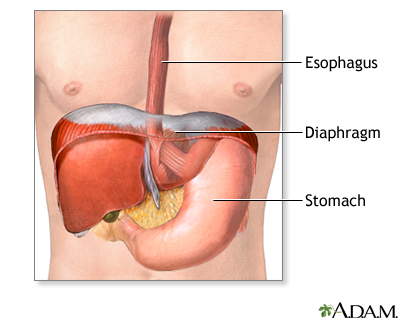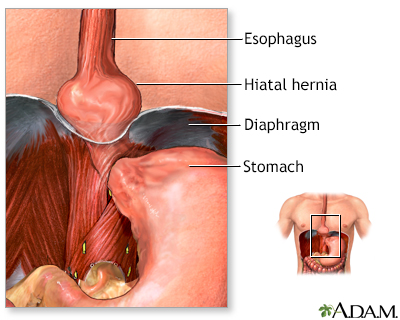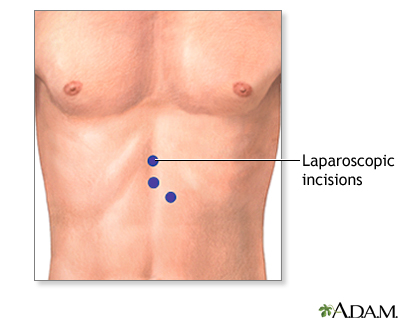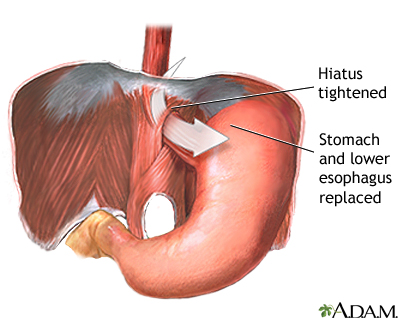Hiatal hernia repair
| Normal anatomy |
|
The esophagus runs through the diaphragm to the stomach. It functions to carry food from the mouth to the stomach. The esophagus passes through the diaphragm just before it meets the stomach, through an opening called the esophageal hiatus.
|
|
| Indications |
|
When the opening (hiatus) in the muscle between the abdomen and chest (diaphragm) is too large, some of the stomach can slip up into the chest cavity. This can cause heartburn (gastro-esophageal reflux; GER) as gastric acid backflows from the stomach into the esophagus. Hiatal hernia repair is surgery to repair a bulging of stomach tissue through the muscle between the abdomen and chest (diaphragm) into the chest (hiatal hernia).
Hiatal hernia repair may be recommended when the patient has:
- Severe heartburn
- Severe inflammation of the esophagus from the backflow of gastric fluid (reflux)
- Narrowing of the opening (hiatus) through the diaphragm (esophageal stricture)
- Chronic inflammation of the lungs (pneumonia) from frequent breathing in (aspiration) of gastric fluids
|
|
| Incision |
|
While the patient is deep asleep and pain-free (general anesthesia), an incision is made in the abdomen.
|
|
| Procedure |
|
The stomach and lower esophagus are placed back into the abdominal cavity. The opening in the diaphragm (hiatus) is tightened and the stomach is stitched in position to prevent reflux. The upper part of the stomach (fundus) may be wrapped around the esophagus (fundoplication) to reduce reflux.
|
|
| Aftercare |
|
Patients may need to spend 3 to 10 days in the hospital after surgery. A tube will be placed into the stomach through the nose and throat (nasogastric tube) during surgery and may remain for a few days. Small, frequent feedings are recommended.
|
|

|
Review Date:
4/21/2025
Reviewed By:
Todd Eisner, MD, Private practice specializing in Gastroenterology in Boca Raton and Delray Beach, Florida at Gastroenterology Consultants of Boca Raton. Affiliate Assistant Professor, Florida Atlantic University School of Medicine. Review provided by VeriMed Healthcare Network. Also reviewed by David C. Dugdale, MD, Medical Director, Brenda Conaway, Editorial Director, and the A.D.A.M. Editorial team. |
The information provided herein should not be used during any medical emergency or for the diagnosis or treatment of any medical condition. A licensed medical professional should be consulted for diagnosis and treatment of any and all medical conditions. Links to other sites are provided for information only -- they do not constitute endorsements of those other sites. No warranty of any kind, either expressed or implied, is made as to the accuracy, reliability, timeliness, or correctness of any translations made by a third-party service of the information provided herein into any other language. � 1997-
A.D.A.M., a business unit of Ebix, Inc. Any duplication or distribution of the information contained herein is strictly prohibited.
� 1997-

All rights reserved.






